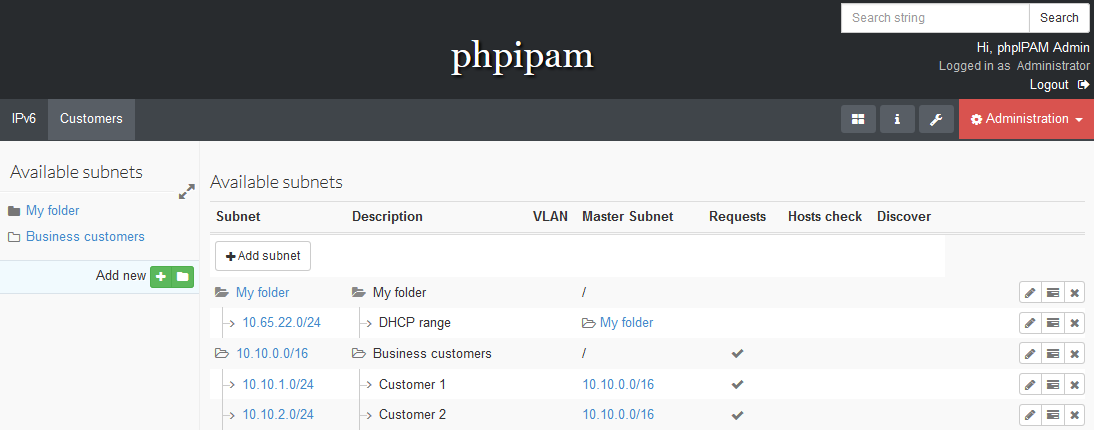phpIPAM is an open-source web IP address management application. Its goal is to provide light and simple IP address management application.
phpIPAM is developed and maintained by Miha Petkovsek, released under the GPL v3 license, project source is here.
Learn more on phpIPAM homepage.
Run a MySQL database, dedicated to phpipam.
$ docker run --name phpipam-mysql -e MYSQL_ROOT_PASSWORD=my-secret-pw -v /my_dir/phpipam:/var/lib/mysql -d mysql:5.6Here, we store data on the host system under /my_dir/phpipam and use a specific root password.
$ docker run -ti -d -p 80:80 -e MYSQL_ENV_MYSQL_ROOT_PASSWORD=my-secret-pw --name ipam --link phpipam-mysql:mysql pierrecdn/phpipamWe are linking the two containers and exposing the HTTP port.
- Browse to
http://<ip>[:<specific_port>]/install/ - Step 1 : Choose 'Automatic database installation'
- Step 2 : Re-Enter connection information
- Note that these two first steps could be swapped by patching phpipam (see phpipam/phpipam#25)
- Step 3 : Configure the admin user password
- You're done !
You can also create an all-in-one YAML deployment descriptor with Docker compose, like this:
version: '2'
services:
mysql:
image: mysql:5.6
environment:
- MYSQL_ROOT_PASSWORD=my-secret-pw
restart: always
volumes:
- db_data:/var/lib/mysql
ipam:
depends_on:
- mysql
image: pierrecdn/phpipam
environment:
- MYSQL_ENV_MYSQL_USER=root
- MYSQL_ENV_MYSQL_ROOT_PASSWORD=my-secret-pw
- MYSQL_ENV_MYSQL_HOST=mysql
ports:
- "80:80"
volumes:
db_data:And next :
$ docker-compose up -dYou can also point the MYSQL_ENV_PASSWORD_FILE environment variable to a file,
in which case the contents of this file will be used as the password.
This makes it possible to use docker secrets for instance:
version: '3'
services:
ipam:
environment:
- MYSQL_ENV_MYSQL_PASSWORD_FILE=/run/secrets/phpipam_mysql_root_password
secrets:
- phpipam_mysql_root_passwordThe secret can be created by running echo my-secret-pw | docker secret create phpipam_mysql_root_password -
Here is the list of the available environment variables in the phpipam container, pass them to docker using -e.
None of them are actually needed to run the container, this is only to tweak the behavior.
| Environment variable | Default value | Description |
|---|---|---|
| MYSQL_ENV_MYSQL_HOST | mysql | The host used to reach the MySQL instance |
| MYSQL_ENV_MYSQL_USER | root | The user to connect the MySQL instance |
| MYSQL_ENV_MYSQL_ROOT_PASSWORD | (empty) | The MySQL password. Can be set using the Web UI during the first install |
| MYSQL_ENV_MYSQL_DB | phpipam | The name of the MySQL DB to connect to |
| MYSQL_ENV_MYSQL_PASSWORD_FILE | (empty) | A file containing the password (if not using MYSQL_ROOT_PASSWORD) this allows to leverage docker secrets |
| PHPIPAM_BASE | / | The base URI under which phpipam runs. Useful when performing rewrites with a reverse-proxy |
| TRUST_X_FORWARDED_HEADERS | false | If operating behind a reverse proxy, set to true to accept the following headers: X_FORWARDED_HOST, X_FORWARDED_PORT, X_FORWARDED_PROTO, X_FORWARDED_SSL, and X_FORWARDED_URI |
| GMAPS_API_KEY | (empty) | Google Maps API Key, used to display maps of your devices |
| GMAPS_API_GEOCODE_KEY | (empty) | Google Maps Geocode API Key, used to find coordinates from an address/ a location of your device |
Regarding your requirements and docker setup, you've to expose resources.
For HTTPS, run a reverse-proxy in front of your phpipam container and link it to.
For multi-host containers, expose ports, run etcd or consul to make service discovery works etc.
phpIPAM is under heavy development by the amazing Miha.
To upgrade the release version, just change the PHPIPAM_VERSION environment variable to the target release (see here).




